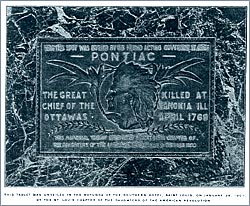Chief Pontiac 250th Anniversary
Commemoration
Lincoln Park, Michigan April 27, 2013
The National American Indian Movement, the National American Indian
Movement Grand Governing Council, the American Indian Movement (AIM) of
Michigan, the Lincoln Park Historical Society and Museum, and the City of
Lincoln Park, Michigan are pleased to announce the 250th Anniversary
Commemoration of Ottawa Chief Pontiac holding Council on the Ecorse River on
April 27, 1763. The commemoration events,
funded in part by Chrysler Corporation and offered free of charge, will take
place at Council Point Park on River Drive in Lincoln Park, from April 19
through April 28, 2013. Numerous
educational, cultural & entertainment programs are planned throughout the
week with noted speakers relating Native American history, culture and current
concerns. The new Michigan Historical Site Marker for Pontiac’s Council will be
dedicated in a State ceremony as part of the commemoration on Saturday, April
27, 2013 at 5:00 P.M. AIM will hold its
annual Pow Wow on April 27th and 28th. Funding opportunities are available and
donations are being accepted to help defray the costs of the public event.
To reflect the
popularity of the Pontiac name over the years, a Classic Pontiac Car Show is being
planned for Thursday, April 25 at Council Point Park, beginning at 5:00 P.M.. Grammy-award winning singer-songwriter Bill
Miller will present a concert on Friday,
April 26 at 6:00 P.M. , followed by a twilight showing of the 2008 film, “Older
than America,” directed by Georgina Lightning.
The original Council was called for April 27, 1763 by
Pontiac with hundreds of chiefs and warriors of many Native Nations in
attendance, including Ottawa, Potawatomi, Wyandot (Huron) and Chippewa. Here, plans were set in motion to capture the
forts in the Great Lakes and Ohio Valley regions and expel the British who gained
control of the vast territory from the French at the close of the French and
Indian War. Pontiac’s plans for an initial
attack at Fort Detroit on May 7 were discovered by Major Henry Gladwin, turning
his attempt for a quick capture into a nearly six-month-long siege, during
which the significant Battle of Bloody Run took place on July 31. Nine of the region’s critical forts were subsequently
taken by the alliance of Nations in a matter of a few weeks time. ‘Pontiac’s War’ became one of the earliest and
most significant wide-spread efforts in the First Nations’ goal to maintain
their ancestral homelands. It would not
be enough to stem the tide of European and later American advancement, however.

